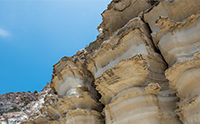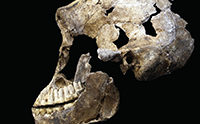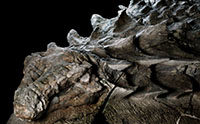Do sediment cores from Canada’s Great Slave Lake give support to such an idea? …read more Source: creation.com
A delicate, fossilised plant unsurprisingly speaks of catastrophic burial. …read more Source: creation.com
On various continents, escarpments stand as a testimony to enormous geological forces. …read more Source: creation.com
The receding waters of Noah’s Flood better explain what shaped geological features such as mountains, valleys and rivers. …read more Read more here: creation.com
By Dr. Neal Doran In 1955, an amateur fossil hunter found a bizarre fossil in Illinois. To this day, the exact nature of this monster remains a mystery. …read more Source: AIG Daily
Caught in the middle of a meal, this fossil clearly speaks of rapid burial. …read more Read more here: creation.com
Fresh images of this dwarf planet’s geology are exciting and point to its young age. …read more Read more here: creation.com
An ape-like lower jaw fossil from Greece and a tooth from Bulgaria now pose a big threat to evolution’s story of mankind’s supposed split from chimpanzees out of Africa 5-7 million years ago. What do these two fossils really tell us? More… …read more Read more here: icr.org
By Ken Ham Many of our supporters have been asking about a recent article by National Geographic magazine. This article features breathtaking photos of a fossil of an incredibly life-like armored dinosaur (called a nodosaur). The photos are absolutely beautiful—the nodosaur looks as if it were a statue or frozen in time. What process or event could preserve a creature that well? (Hint: the Bible gives us the answer!) Interestingly, this find was accidental. Miners in Alberta, Canada, uncovered the dinosaur and, thankfully, reported it so it could be saved for research and display. This fossil is so well …read [More]
Analysis of wood samples from Tertiary rocks yielded significant carbon-14 indicating the wood was only thousands of years old, not millions. …read more Read more here: creation.com
Homo naledi, the latest failed candidate for a missing link in human evolution, was deposited in the Rising Star cave system in South Africa. New fossil dating attempts reveal troubling difficulties with science’s attempt at answering historical questions. More… …read more Read more here: icr.org
By Laura Allnutt Brontosaurus, a diplodocid, is a family of dinosaurs with similar shape and form, so similar that the Brontosaurus has caused quite a bit of confusion. …read more Read more here: AIG Daily
How do we interpret the latest Homo naledi findings with their associated ‘ape-man’ connotations and claims? …read more Read more here: creation.com
The catastrophic event that revealed how wrongly geologists understood and explained volcanic landscapes. …read more Read more here: creation.com
Another spectacular dinosaur fossil discovery has baffled paleontologists who deny the historical accuracy of the book of Genesis. New Scientist recently reported the identification of a T. rex-like dinosaur from Upper Cretaceous system rocks in North Africa. What confounded the scientists were the phosphate-rich rocks in which the bones were found—rocks indicative of deposition in an open ocean. More… …read more Read more here: icr.org
By Ken Ham National Geographic recently ran an interesting story about the scablands in Washington State. The subtitle reads, “Geologists couldn’t account for the strange landforms of eastern Washington State. Then a high school teacher dared to question the scientific dogma of his day.” In 1909, high-school-teacher-turned-geologist J. Harlen Bretz noticed that the features of the scablands couldn’t be the result of slow and gradual processes over millions of years as was commonly believed at the time. He proposed that a massive flood carved out these startling features. But this “was geological heresy,” and his ideas were dismissed. And it [More]
The majority of dinosaur skeletons are cobbled together from fossil fragments. But a nodosaur recently put on display was so well preserved that it looks like a “statue.” It even contains tissue fragments. How could such a well-preserved dinosaur remain intact for millions of years? More… …read more Read more here: icr.org
A fossil graveyard in Michigan gives another example of Flood catastrophism. …read more Read more here: creation.com
By using the same methods that long-age geochronologists employ, we can propose a timeframe for the end of the Ice Age. …read more Read more here: creation.com
Tree trunks engulfed by molten lava couldn’t survive could they? Here’s evidence that they did! …read more Read more here: creation.com
Rapid erosion means a recently-formed gorge in Taiwan could disappear within 50 years. …read more Read more here: creation.com
Atheists are convinced life came into being by naturalistic processes, but do their conclusions match the evidence? …read more Read more here: creation.com
By Dr. Andrew A. Snelling Let’s take a closer look at the radioactive dating method and the radiometric dating methods and see how reliable they really are. …read more Read more here: AIG Daily
Testing the waters to see if this idea explains how massive coal beds were formed. …read more Read more here: creation.com
By Dr. Andrew A. Snelling Although many people think radiocarbon is used to date rocks, it is limited to dating things that contain carbon and were once alive (fossils). …read more Read more here: AIG Daily
By Dr. Andrew A. Snelling The idea that continents move sounds crazy . . . until you look at the facts. …read more Read more here: AIG Daily
By Dr. Andrew A. Snelling NCSU’s recent research revealed an “oversight in a radioisotope dating technique used to date everything from meteorites to geologic samples.” …read more Read more here: AIG Daily




















![Swing Down Chariot [Live] Swing Down Chariot [Live]](http://img.youtube.com/vi/5QXXFCw_4k8/0.jpg)


























